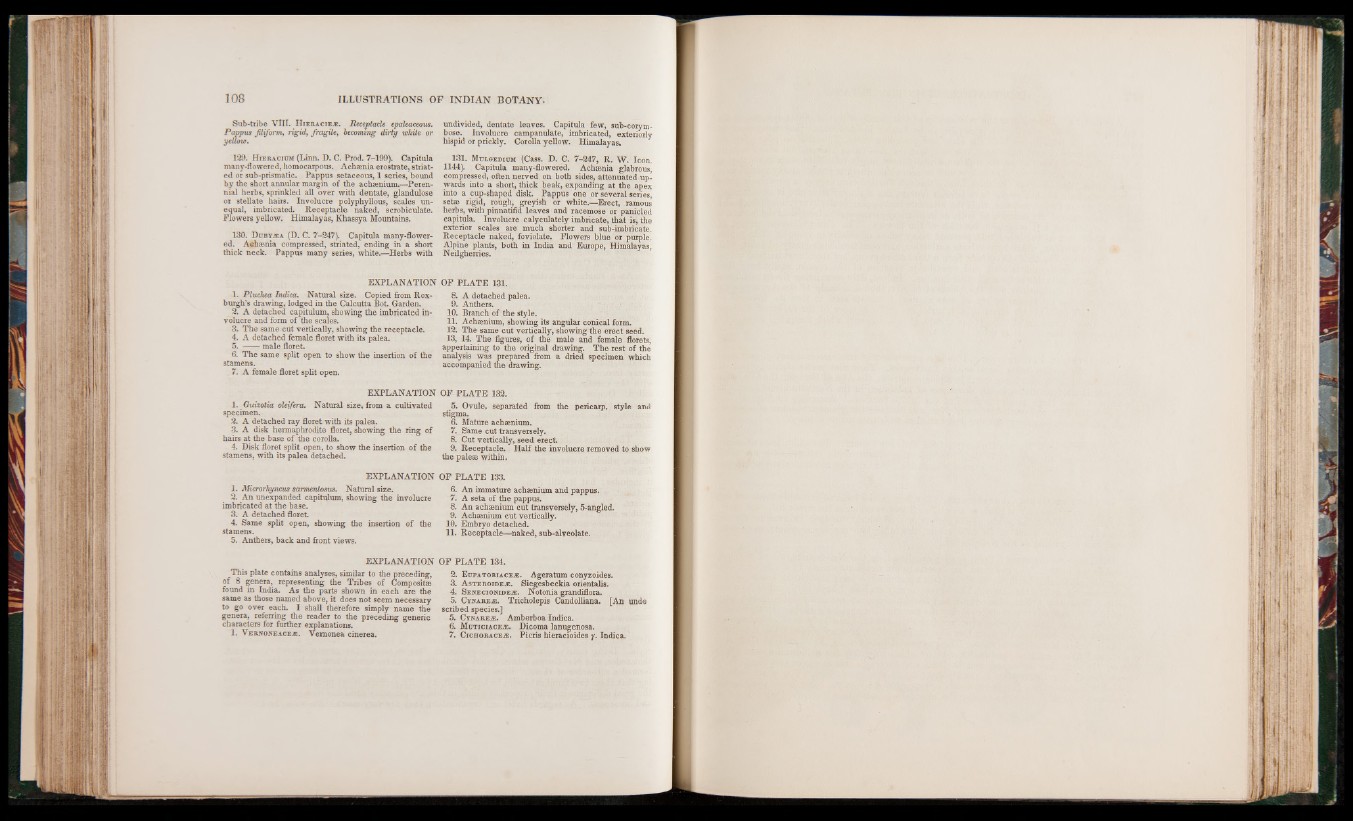
Sub-tribe VIII. H ieracieje. Receptacle epaleaceous.
Pappus Jiliform, rigid, fragile, becoming dirty white or
yellow.
129. Hieracium (Linn. D. C. Prod. 7-199). Capitula
many-flowered, homocarpous. Achsenia erostrate, striated
or sub-prismatic. Pappus setaceous, 1 series, bound
by the short annular margin of the achaenium.—Perennial
herbs, sprinkled all over with dentate, glandulose
or stellate hairs. Involucre polyphyllous, scales unequal,
imbricated. Receptacle naked, scrobiculate.
Flowers yellow. Himalayas, Khassya Mountains.
130. Dubyjda (D. C. 7-247). Capitula many-flowered.
Achsenia compressed, striated, ending in a short
thick neck. Pappus many series, white.—Herbs with
undivided, dentate leaves. Capitula few, sub-corymbose.
Involucre campanulate, imbricated, exteriorly
hispid or prickly. Corolla yellow. Himalayas.
131. Mulgedium (Cass. D. C. 7-247, R. W. Icon.
1144). Capitula many-flowered. Achsenia glabrous,
compressed, often nerved on both sides, attenuated upwards
into a short, thick beak, expanding at the apex
into a cup-shaped disk. Pappus one or several series,
setae rigid, rough, greyish or white.—Erect, ramous
herbs, with pinnatifid leaves and racemose or panicled
capitula. Involucre calyculately imbricate, that is, the
exterior scales are much shorter and sub-imbricate.
Receptacle naked, foviolate. Flowers blue or purple.
Alpine plants, both in India and Europe, Himalayas,
Neilghemes.
EXPLANATION OF PLATE 131.
1. Pluchea Indica. Natural size. Copied from Roxburgh’s
drawing, lodged in the Calcutta Bot. Garden.
2. A detached capitulum, showing the imbricated involucre
and form of the scales.
3. The same cut vertically, showing the receptacle.
4. A detached female floret with its palea.
5. ------male floret.
6. The same split open to show the insertion of the
stamens.
7. A female floret split open.
8. A detached palea.
9. Anthers.
10. Branch of the style.
11. Achaenium, showing its angular conical form.
12. The same cut vertically, showing the erect seed.
13. 14. The figures, of the male and female florets,
appertaining to the original drawing, The rest of the
analysis was prepared from a dried specimen which
accompanied the drawing.
EXPLANATION OF PLATE 132.
1. Guizotia oleifera. Natural size, from a cultivated
specimen.
2. A detached ray floret with its palea.
3. A disk hermaphrodite floret, showing the ring of
hairs at the base of the corolla.
4. Disk floret split open, to show the insertion of the
stamens, with its palea detached.
5. Ovule, separated from the pericarp, style and
stigma.
6. Mature achaenium.
7. Same cut transversely.
8. Cut vertically, seed erect
9. Receptacle. Half the involucre removed to show
the pale* within.
EXPLANATION OF PLATE 133.
1. Microrhyncus sarmentosus. Natural size.
2. An unexpanded capitulum, showing the involucre
imbricated at the base.
3. A detached floret
4. Same split open, showing the insertion of the
stamens.
5. Anthers, back and front views.
6. An immature achaenium and pappus.
7. A seta of the pappus.
8. An achaenium cut transversely, 5-angled.
9. Achaenium cut vertically.
10. Embryo detached.
11. Receptacle—naked, sub-alveolate.
EXPLANATION OF PLATE 134.
This plate contains analyses, similar to the preceding,
of 8 genera, representing the Tribes of Compositae
found in India. As the parts shown in each are the
same as those named above, it does not seem necessary
to go over each. I shall therefore simply name the
genera, referring the reader to the preceding generic
characters for further explanations.
1. Vernoneaceje. Yemonea cinerea.
2. Eufatoriaceæ. Agératum conyzoides.
3. A steroideæ. Siegesbeckia orientalis.
4. Senecionideæ. Notonia grandiflora.
5. Cynareæ. Tricholepis Candolliana. [An unde
scribed species.]
5. Cynareæ. Amberboa Indica.
6. Müticiaceæ. Dicoma lanugenosa.
7. Cichoraceæ. Picris hieracioides y. Indica.